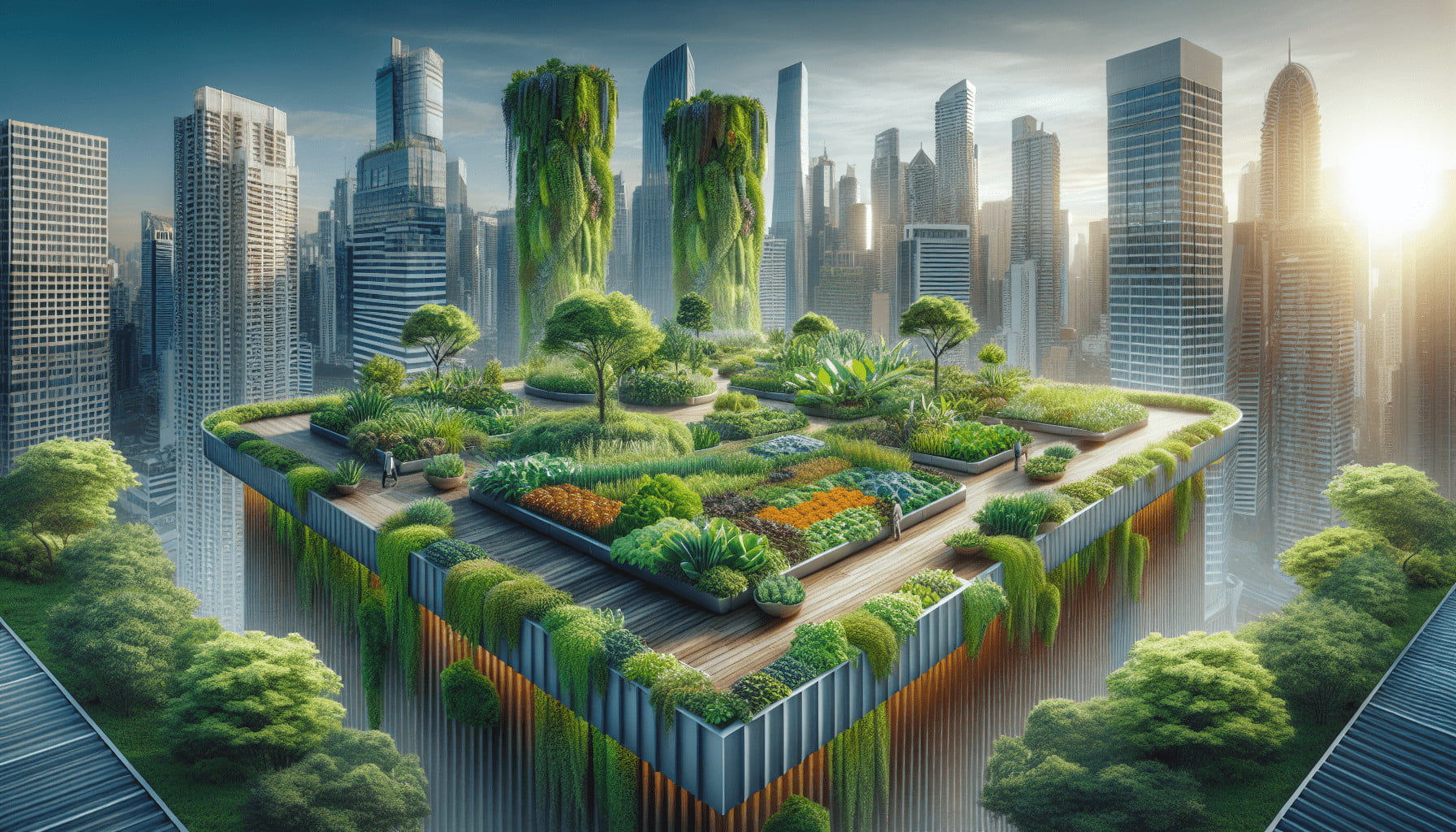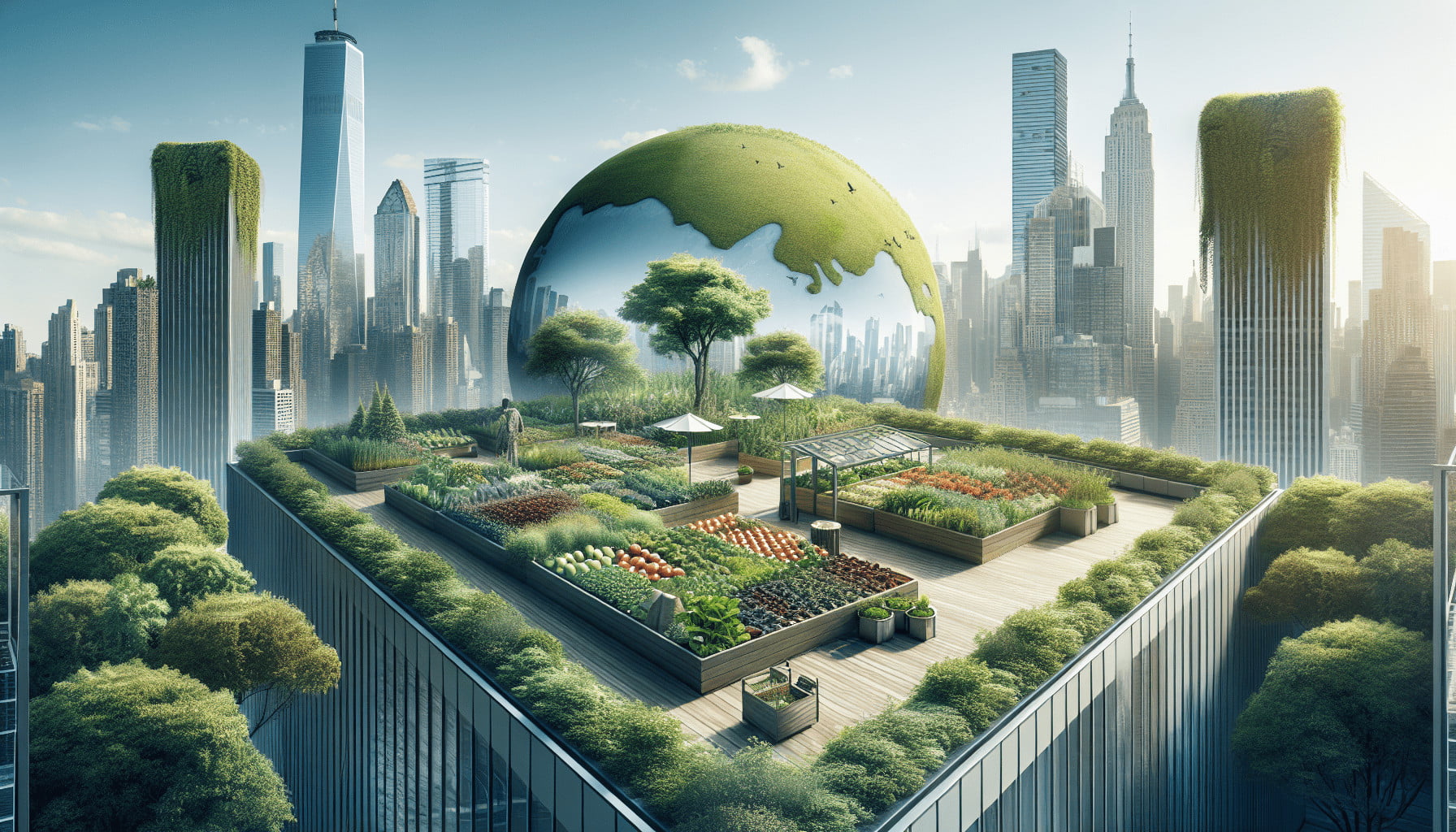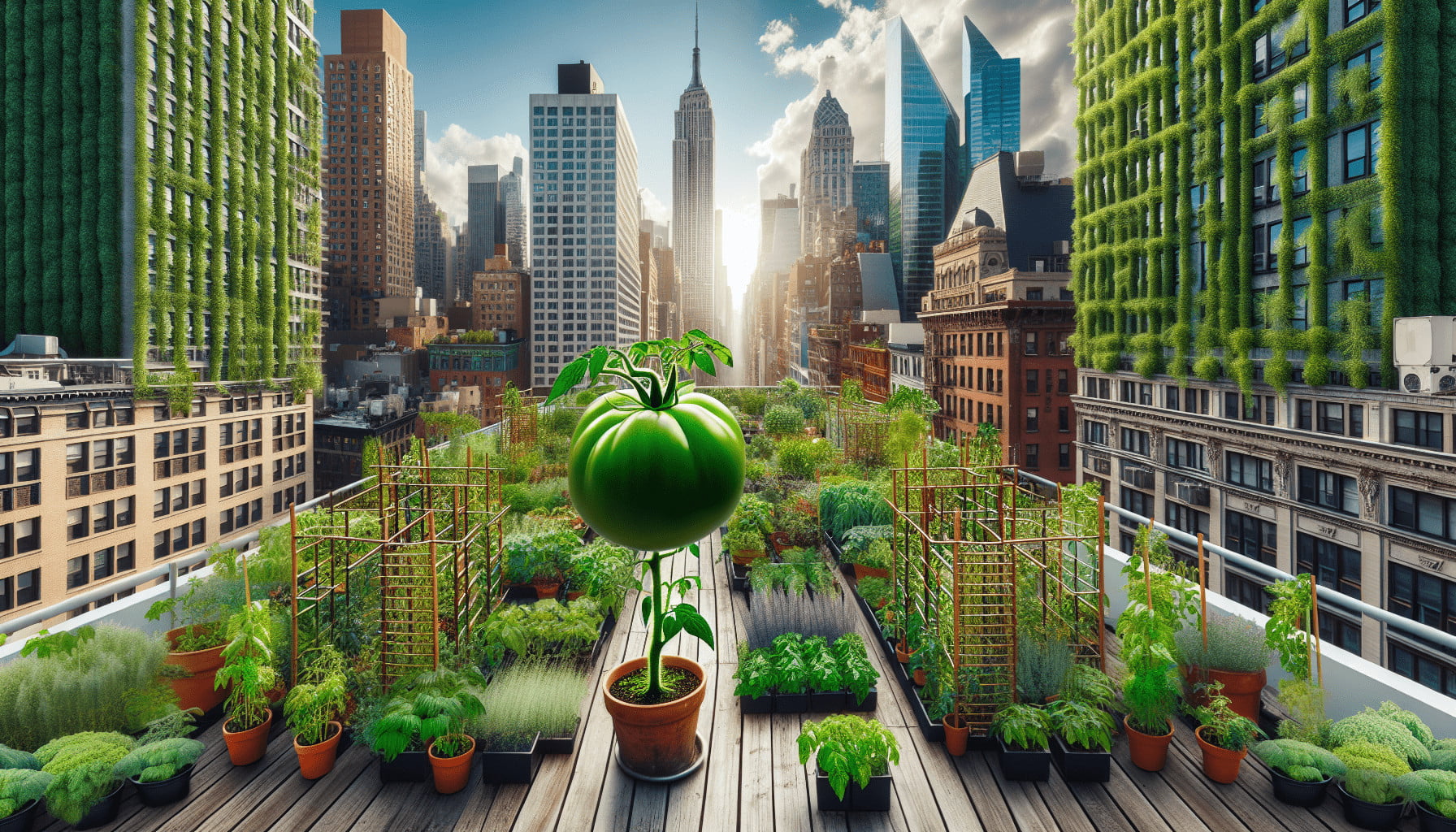Imagine having your own rooftop garden filled with beautiful plants that not only add visual appeal to your space but also provide delicious fruits and vegetables for you to enjoy. In this article, we will explore the benefits and possibilities of incorporating edible plants into your rooftop garden design. From selecting the right plants to maximizing space and ensuring proper care, you will discover how to create a sustainable and mouthwatering oasis in the heart of the city. So, get ready to explore the exciting world of rooftop gardening and unlock the potential of incorporating edible plants into your urban escape.
Benefits of Incorporating Edible Plants
Enhance Food Security
Incorporating edible plants into your rooftop garden design can greatly enhance your food security. By growing your own food, you have better control over the quality and safety of the produce you consume. You can also reduce your dependence on grocery stores and have a constant supply of fresh, organic food at your fingertips. In times of food shortages or emergencies, having a rooftop garden with edible plants can be a valuable source of sustenance.
Promote Sustainability
Rooftop gardening with edible plants is a sustainable practice that helps to lessen the environmental impact of traditional agriculture. By growing your own food, you reduce the need for transportation and packaging, which in turn reduces carbon emissions. Additionally, rooftop gardens can help to mitigate the urban heat island effect by providing shade and cooling the surrounding areas. By incorporating edible plants into your rooftop garden, you are contributing to a more sustainable and eco-friendly lifestyle.
Provide Nutritional Benefits
One of the key benefits of incorporating edible plants into your rooftop garden is the nutritional value they provide. Freshly picked fruits, vegetables, and herbs are packed with essential vitamins, minerals, and antioxidants, offering a myriad of health benefits. By growing your own food, you can ensure that you and your family have access to a variety of nutrient-rich produce, contributing to a well-balanced and healthy diet.
Reduce Grocery Expenses
Growing your own food can significantly reduce your grocery expenses. By incorporating edible plants into your rooftop garden, you eliminate the need to purchase these items from the store. This can amount to substantial savings over time, especially considering the rising costs of fresh produce. Additionally, by growing your own food, you have the opportunity to experiment with unique and exotic varieties that may not be readily available in stores, further enhancing your culinary experience.
Considerations for Rooftop Gardening
Structural Integrity
Before embarking on your rooftop gardening journey, it is crucial to assess the structural integrity of your rooftop. Not all roofs are designed to accommodate the weight of a garden, so it is important to consult with a structural engineer or a professional in rooftop gardening to ensure that your rooftop can support the additional load. This step will help prevent any potential damage to your property and ensure your safety.
Weight Capacity
Knowing the weight capacity of your rooftop is essential when planning your rooftop garden. Different types of plants and gardening systems have varying weight requirements. It is important to consider the weight of the plants, soil, containers, and any structures such as trellises or arbors. By staying within the weight limits of your rooftop, you can avoid any structural issues and ensure the longevity of your garden.
Watering and Drainage
Proper watering and drainage are crucial factors in rooftop gardening. The limited space and exposure to elements make it necessary to have efficient watering systems in place. Consider installing drip irrigation or a self-watering system to ensure that your plants receive adequate hydration without wasting water. In terms of drainage, make sure that your rooftop has proper outlets and that excess water can flow freely, preventing water damage to the roof structure.
Sunlight and Shade
Sunlight is a vital component for the growth and development of plants. Before choosing your plants, assess the amount of sunlight your rooftop receives throughout the day. Some edible plants thrive in full sun, while others prefer partial shade. Understanding the sunlight patterns on your rooftop will help you select the appropriate plants and ensure their optimal growth. Consider incorporating shade structures or shade-loving plants to provide relief for plants that cannot tolerate intense sunlight.

Choosing Edible Plants for Your Rooftop Garden
Climate Compatibility
When selecting edible plants for your rooftop garden, it is important to consider the climate in which you live. Different plants have specific temperature and humidity requirements for healthy growth. Some plants thrive in cooler climates, while others prefer warmer or tropical environments. Research the climate compatibility of the plants you intend to grow and choose varieties that are well-suited to your local climate conditions.
Space Availability
The available space on your rooftop will dictate the types and quantity of edible plants you can grow. Assess the size and layout of your rooftop, taking into consideration any structural elements such as chimneys or air conditioning units. Opt for plants that have compact growth habits or explore vertical gardening techniques to maximize space utilization. By carefully planning the layout and choosing space-efficient plants, you can make the most of your rooftop garden.
Growing Season
Understanding the growing season in your area is crucial for successful rooftop gardening. Some plants have longer growing seasons, while others are suitable for shorter growing periods. Consider the average frost dates in your region and select plants that can thrive within that timeframe. Alternatively, invest in season-extending techniques such as cold frames or row covers to prolong the growing season and increase your crop yield.
Maintenance Requirements
Different edible plants have varying maintenance requirements. Some plants are more tolerant of neglect and require minimal care, while others demand regular attention and upkeep. Consider the amount of time and effort you are willing to devote to your rooftop garden and choose plants accordingly. If you have limited time to spare, opt for low-maintenance plants that still provide a bountiful harvest, allowing you to enjoy the benefits of your garden without feeling overwhelmed.
Designing Your Rooftop Garden with Edible Plants
Layout Planning
Before you start planting, it is important to plan the layout of your rooftop garden. Take into consideration the available space, sunlight exposure, and access points. Create a rough sketch or use online garden planning tools to map out the location of plants, walkways, and any other features you wish to incorporate, such as seating areas or storage. Proper layout planning will ensure a functional and visually appealing rooftop garden.
Vertical Gardening
Vertical gardening is an excellent technique for maximizing space in a rooftop garden. By growing plants vertically, you can take advantage of unused wall space and create a lush and beautiful garden. Install trellises, arbors, or wall planters to support climbing plants such as cucumbers, tomatoes, or beans. This technique not only adds visual interest to your rooftop garden but also increases your overall crop yield.
Container Gardening
Container gardening is a popular choice for rooftop gardens due to its flexibility and portability. Select appropriate containers for your plants, ensuring they have sufficient drainage holes and are made from lightweight materials to avoid adding unnecessary weight to your rooftop. Additionally, consider incorporating self-watering containers to simplify the watering process and ensure your plants receive the necessary moisture. Experiment with different container sizes and styles to create a dynamic and diverse rooftop garden.
Companion Planting
Companion planting is a gardening technique that involves planting different species together to maximize growth and yield. Certain plants have beneficial relationships with each other, such as repelling pests or enhancing nutrient absorption. Research companion planting combinations that are suitable for your chosen edible plants. By incorporating companion planting into your rooftop garden design, you not only promote overall plant health but also create a visually appealing and harmonious garden.

Essential Tools and Materials
Garden Gloves
Garden gloves are an essential tool for any rooftop gardener. They protect your hands from cuts, blisters, and contact with soil-borne diseases. Choose gloves that are comfortable, durable, and provide sufficient grip. Whether you are planting, pruning, or harvesting, wearing gloves will ensure that you can work in your rooftop garden comfortably and safely.
Garden Trowel
A garden trowel is a versatile and indispensable tool for rooftop gardening. It is used for digging, transplanting, and loosening soil. Invest in a high-quality, sturdy garden trowel that will withstand the demands of rooftop gardening. Look for features such as an ergonomic handle and rust-resistant materials to ensure longevity and ease of use.
Plant Containers
Plant containers are essential for rooftop gardening, as they provide a suitable environment for plants to grow. Choose containers that are appropriate for the size and needs of your plants, ensuring they have proper drainage holes. Opt for lightweight containers made from materials such as plastic, fiberglass, or fabric to minimize the weight impact on your rooftop. Consider incorporating different sizes and styles to add visual interest to your rooftop garden.
Compost and Fertilizers
Compost and fertilizers are essential for nourishing your plants and promoting healthy growth. Organic compost provides essential nutrients to the soil and improves its structure and water-holding capacity. Incorporate compost into your planting beds or use it as a top dressing for container plants. Additionally, consider using organic fertilizers to supplement the nutrient needs of your plants. Choose slow-release or liquid fertilizers that are suitable for the specific requirements of your chosen edible plants.
Tips for Successful Rooftop Gardening
Start with Easy-to-Grow Plants
If you are new to rooftop gardening, it is advisable to start with easy-to-grow plants. Choose varieties that are known for their hardiness and adaptability. Some examples include lettuce, herbs like basil or mint, or cherry tomatoes. By starting with plants that are more forgiving and less demanding, you can gain experience and confidence in your gardening skills before experimenting with more challenging varieties.
Pay Attention to Irrigation
Proper irrigation is crucial for the health and success of your rooftop garden. Monitor the moisture levels of your soil regularly and adjust your watering schedule accordingly. Avoid overwatering, as it can lead to root rot or waterlogged soil. Install a rainwater harvesting system or consider using a drip irrigation system to ensure efficient water usage. By paying attention to irrigation, you can prevent potential plant stress and maintain the overall health of your rooftop garden.
Monitor for Pests and Diseases
Like any garden, rooftop gardens are susceptible to pests and diseases. Regularly inspect your plants for signs of pests such as aphids, spider mites, or snails. Consider implementing organic pest control methods such as companion planting, introducing beneficial insects, or using organic pesticides when necessary. Additionally, keep an eye out for any signs of diseases such as powdery mildew or root rot. Promptly address any issues to prevent the spread and deterioration of your plants.
Harvest at the Right Time
To fully enjoy the benefits of your rooftop garden, it is important to harvest your produce at the right time. Each plant has different maturity and ripeness indicators, so familiarize yourself with the specific requirements of your chosen edible plants. Harvesting too early or too late can adversely affect the flavor and quality of your produce. By harvesting at the peak of freshness, you can savor the delicious flavors and nutritional benefits of your rooftop garden’s bounty.

Common Edible Plants for Rooftop Gardens
Herbs: Basil, Mint, Rosemary
Herbs are a popular choice for rooftop gardens due to their compact size, versatility, and culinary value. Basil, mint, and rosemary are commonly grown herbs that thrive in container environments. Basil adds a fragrant and vibrant touch to dishes, mint offers refreshing flavors, and rosemary imparts a distinct aroma to various recipes. These herbs are relatively easy to grow and can be harvested repeatedly, making them ideal additions to your rooftop garden.
Leafy Greens: Lettuce, Spinach, Kale
Leafy greens are nutritious and easy to grow, making them excellent choices for rooftop gardens. Lettuce, spinach, and kale are versatile leafy greens that can be used in salads, stir-fries, or as sandwich fillings. These greens are relatively fast-growing and can be harvested at various stages of growth. Incorporating leafy greens into your rooftop garden not only adds visual appeal but also provides you with a steady supply of fresh, healthy greens.
Fruits: Strawberries, Tomatoes, Blueberries
Growing fruits in a rooftop garden can be a rewarding experience. Strawberries, tomatoes, and blueberries are popular choices for urban gardeners due to their compact growth habits and delicious flavors. Strawberries can be grown in hanging baskets or containers, while tomatoes thrive in larger pots or raised beds. Blueberries require slightly acidic soil and can be grown in containers specifically designed for acid-loving plants. Adding fruits to your rooftop garden introduces vibrant colors and sweetness to your harvest.
Vegetables: Peppers, Cucumbers, Radishes
Vegetables are staple crops for many rooftop gardens. Peppers, cucumbers, and radishes are versatile vegetables that can thrive in container environments. Peppers come in various shapes and sizes, offering a range of flavors and spice levels. Cucumbers are refreshing and can be enjoyed fresh or pickled. Radishes are quick-growing root vegetables that add a satisfying crunch to salads and sandwiches. Growing these vegetables in your rooftop garden allows you to enjoy a diverse array of fresh produce throughout the growing season.
Maximizing the Use of Vertical Space
Wall Planters
Wall planters are an excellent way to maximize vertical space in your rooftop garden. These planters can be installed directly onto walls or fences, allowing you to grow a variety of plants in a compact area. Choose wall planters that are lightweight and durable, and ensure they have proper drainage to prevent water accumulation. By utilizing wall planters, you can create a visually stunning vertical garden while making the most of limited space.
Hanging Baskets
Hanging baskets are another effective method for utilizing vertical space in a rooftop garden. These baskets can be suspended from trellises, awnings, or other overhead structures. Select hanging baskets that are appropriate for the size and weight of your chosen plants. Opt for cascading or trailing plants such as strawberries, trailing herbs, or ivy to create a lush and dynamic display. Hanging baskets not only add visual interest to your rooftop garden but also help to maximize your green space.
Trellises and Arbors
Trellises and arbors are versatile structures that provide support for climbing plants. By incorporating trellises or arbors into your rooftop garden, you can grow vining vegetables such as beans, peas, or cucumbers vertically, minimizing the need for horizontal space. Consider using lightweight and weather-resistant materials such as bamboo or metal for the construction of trellises and arbors. By utilizing these structures, you can create a beautiful and functional rooftop garden that maximizes space utilization.
Climbing Plants
Climbing plants are ideal for rooftop gardens with limited space. These plants take advantage of vertical structures to grow upward, freeing up valuable ground space. Choose climbing plants that are well-suited to your rooftop’s growing conditions, such as climbing roses, jasmine, or morning glories. Install trellises, lattice panels, or wall-mounted supports to provide ample space for the plants to climb. By incorporating climbing plants into your rooftop garden, you can create a lush and vibrant oasis in a confined area.

Creating a Sustainable Rooftop Garden
Composting
Composting is an essential component of sustainable gardening. By composting organic waste such as kitchen scraps, yard trimmings, and plant debris, you can create nutrient-rich compost that nourishes your plants. Consider establishing a composting system on your rooftop, using a worm bin or a compost tumbler. By composting your organic waste, you reduce landfill waste and produce a valuable resource for your rooftop garden.
Rainwater Harvesting
Rooftop gardens can benefit greatly from rainwater harvesting. Set up rain barrels or a rainwater collection system to capture and store rainwater for irrigation purposes. Rainwater is free of chemicals and ideal for watering your plants, reducing your reliance on municipal water sources. By implementing rainwater harvesting in your rooftop garden, you contribute to water conservation efforts while maintaining a sustainable and environmentally friendly gardening practice.
Using Sustainable Materials
When designing and constructing your rooftop garden, opt for sustainable materials whenever possible. Choose containers, trellises, and support structures made from recycled materials or renewable resources. Use organic and biodegradable mulches to suppress weeds and improve soil health. By consciously selecting sustainable materials, you reduce your carbon footprint and promote a more environmentally friendly rooftop garden.
Avoiding Chemical Pesticides
Incorporating organic pest control measures can greatly contribute to a sustainable rooftop garden. Avoid using chemical pesticides, which can harm beneficial insects and contaminate the environment. Instead, opt for organic pest control methods such as companion planting, introducing natural predators, or making homemade organic sprays. By avoiding chemical pesticides, you ensure that your rooftop garden remains free from harmful substances and supports a healthy ecosystem.
Harvesting and Enjoying the Fruits of Your Labor
Proper Harvesting Techniques
Proper harvesting techniques are crucial for maximizing the flavor and quality of your rooftop garden produce. Each edible plant has different requirements for harvesting. Some fruits and vegetables are best harvested when fully ripe, while others should be picked slightly underripe. Research specific harvesting techniques for each plant in your rooftop garden to ensure you achieve optimal flavor and texture.
Creative and Delicious Recipes
Once you have harvested your rooftop garden produce, the possibilities for delicious meals are endless. Get creative in the kitchen and explore new recipes that highlight the flavors of your homegrown ingredients. Fresh basil can be transformed into pesto, mint can be used in refreshing summer drinks, and tomatoes can be turned into flavorful sauces or salsas. Experiment with different flavor combinations and enjoy the true taste of your rooftop garden.
Sharing Your Harvest
A bountiful rooftop garden can produce more food than you and your family can consume alone. Consider sharing your harvest with friends, family, or neighbors. Not only does sharing foster a sense of community, but it also reduces food waste and allows others to enjoy the benefits of your rooftop garden. Share your surplus fruits, vegetables, or herbs, and spread the joy of homegrown produce.
Preservation Methods
Preserving your rooftop garden harvest allows you to enjoy the flavors of your garden year-round. Explore various preservation methods such as canning, freezing, or dehydrating to store your produce for the future. Make jams and jellies from berries, freeze herbs into convenient cubes, or pickle cucumbers for tangy snacks. By preserving your harvest, you can savor the taste of your rooftop garden even during the colder months.
Incorporating edible plants into your rooftop garden design has numerous benefits. From enhancing food security and promoting sustainability to providing nutritional benefits and reducing grocery expenses, a rooftop garden with edible plants can transform your living space and your relationship with food. By considering the structural integrity, weight capacity, watering and drainage, and sunlight and shade of your rooftop, you can create a thriving garden environment. Choose edible plants that are compatible with your climate, make the most of available space, and align with your preferred growing season and maintenance capabilities. Incorporate design elements such as layout planning, vertical gardening, container gardening, and companion planting to create a functional and visually appealing rooftop garden. Equip yourself with essential tools and materials, and follow tips for successful rooftop gardening, including starting with easy-to-grow plants, paying attention to irrigation and pest control, and harvesting at the right time. Consider common edible plants like herbs, leafy greens, fruits, and vegetables for your rooftop garden, and explore ways to maximize vertical space utilization. Create a sustainable rooftop garden by composting, collecting rainwater, using sustainable materials, and avoiding chemical pesticides. Once your garden is thriving, enjoy the fruits of your labor through proper harvesting techniques, creative recipes, sharing with others, and preserving your harvest for future enjoyment. Happy rooftop gardening!
